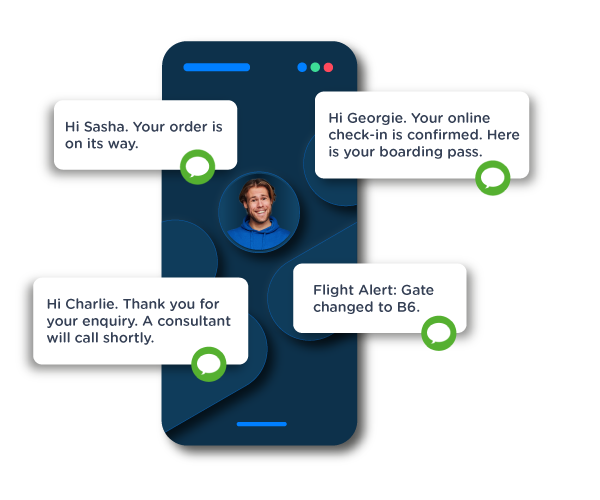What is SMS?
SMS – Short Message Service – is a long-established messaging service, allowing mobile phones to exchange text messages of up to 160 characters. Any mobile phone, anywhere in the world can send and receive texts with SMS, making it incredibly useful as a marketing and customer service channel.
Despite being one of the earliest mobile messaging technologies, SMS remains useful today due to its installed base in the billions.
What SMS Means?
SMS stands for Short Message Service. It provides an easy and reliable way to exchange messages with practically anyone who owns a phone, worldwide. And SMS messages are no longer limited to text; MMS extends the standard with images, while emoticons and other language symbols have extended the original ASCII Latin character set. And with the right software (and subject to regulatory compliance) marketers can send whole campaigns, customer service communications, and special offers to thousands of people a minute.

While a smartphone user can never be certain an email or similar message will be readable on the recipient’s phone – they may not have the right app installed, or simply not use their phone for that purpose – there’s a very high chance that an SMS message will be successfully delivered, and successfully read.
How to Make Your SMS Strategy Succeed? Read More >
How Does SMS Work?
Surprisingly, SMS didn’t start with communication between phone users in mind. The original idea was to give network providers a way to send updates of events to their customers – one-way only, such as voicemail notifications. And the first text message, back in 1992, was sent from a desktop PC because most phones at the time didn’t have alphanumeric keyboards.
Limits were set because network capacities were far lower than today (SMS was designed in the pre-digital world). The specification had to put as little load as possible on global telephony networks. So its creators designed it to use “signaling paths” (technology on a phone network that sets up and ends a voice call) at times those paths weren’t in use (this is why an SMS is fast but not instant).
Because all global telephony networks used similar signaling paths – without them, international calls would have been impossible – this choice enabled SMS to be adopted worldwide, with the “rules” for building a device that could receive, display, and send SMS messages widely understood. So instead of confusion about national standards, the whole world knew how to build SMS functionality into their networks.
Importantly, the SMS standard was open. Any network or hardware provider could implement SMS functionality in their products and services, and be sure it would interoperate with other networks and devices. Another bonus: a mobile phone does not need an internet connection to use SMS – messages are sent over the mobile infrastructure, not the web or email.
Mobile phone users started becoming aware of SMS around the time GSM networks started to roll out around the world. The specifications for GSM included three forms of SMS: SMS-MT (network notifications by the network provider) SMS-CB (“broadcasts” to all devices on a network) and – most importantly – SMS-MO (messages between mobile phones).
Even in today’s web-connected world of 5G, there are still regions where SMS is the principal form of text-based communication – and many where it’s still the only one available.
What is an SMS Service Provider?
SMS service providers are often technology companies with a deep understanding of Short Message Services, buying rights to send large volumes of text messages from the networks and building their own services on top, such as software that makes it easy to create and manage SMS marketing campaigns.
These providers (like CM.com) are the ideal first stop for any company interested in SMS as a communications channel with customers. Many levels of service are available, and providers compete fiercely to give the best customer service and extended functionality.
What Are the Benefits of SMS Messaging?
Immediate and High Readership
While our laptops and desktops aren’t always on our side, mobile phones are. In fact, they tend to remain within two meters of us, 24 hours a day! That means SMS messages tend to be read quickly, often within minutes. That gives SMS an advantage over email marketing or telephone outreach.
Time and Location Sensitivity
Working through a wireless device almost everyone carries, SMS is ideal for delivering timely content such as reservation confirmations and PIN codes for two-factor security. And with most phones now internet-capable, SMS can interoperate with the web – for example, a clickable URL in a text message can lead to the location of a business on Google Maps.
Universal Interoperability
Essentially any mobile phone ever made can send and receive SMS messages, even if they’re over 25 years old. With no internet coverage required. The technology is simple, robust, and well-understood by all network providers – making SMS extremely reliable.
Bulk SMS Messaging
SMS broadcast makes it possible for a marketer to “burst” thousands of messages to an opted-in customer base, providing a cheap and simple way to offer news, updates, and sales promotions. It doesn’t need anyone to tap the message into a phone – campaigns are run through a purpose-built dashboard often linked to CRM applications in the cloud, bringing SMS alongside email, video messaging, and the web as a customer communications channel.
Commercial Options
In addition to the original business model of charging customers to send texts, an SMS Short Code lets marketers earn a fee from people messaging a special number. Uses include voting in TV talent shows and charitable giving.
Multiple Technological Extensions
SMS hasn’t stopped development. A text message is no longer limited to 160 characters by most providers; software on the phone automatically “concatenates” (joins together) longer messages for easy readability. MMS (Multimedia Messaging Service) uses the same underlying technology to send images, too. While in parts of Africa, SMS is used as a form of currency, mobile-to-mobile payments are possible even in remote areas and between older hardware. Even today new applications are being developed using SMS as the base.
What is the Difference Between SMS and MMS?
MMS stands for Multimedia Messaging Service. It’s an evolution of SMS, based on the same technical infrastructure and standards – which means it carries many of the same advantages as SMS, namely that billions of phones worldwide can use it!
First, MMS answers SMS’s most fundamental limitation: the 160-character maximum. (Yes, you can send a text message with MMS, even if you’re not sending a picture!) While MMS can send a broader range of richer content: an image, a gallery of images, short videos of up to 40 seconds, or even an audio message.
The main technical difference with MMS is that it handles these MIME (non-text) extensions, such as images and video. There are also workarounds that apply if you send an MMS message to a non-MMS capable device or region: workflows can be built that convert an MMS into an SMS containing a link to the multimedia content on an HTTP (web) server. But while MMS has greater capabilities than SMS, they’re part of the same family.
What Are SMS Use Cases?
All this makes SMS useful in a wide variety of business situations. Anywhere you need to message customers with reliable delivery, and high readability, and where information is time-sensitive, SMS is an option.
SMS also provides a jumping-off point to richer and more colorful services like web pages and streaming media. Possibilities include:
Urgent Notifications to Individuals and Groups
SMS is ideal for the travel and hospitality sector. A timely SMS “guide” a customer through an unfamiliar airport, or provide booking details shortly before check-in opens. While time-limited sales and promotions can offer deals to selected customer groups for set periods, driving sales.
 Broadcast Messages to a User Base
Broadcast Messages to a User Base
With CM.com’s API connecting SMS services to others like a cloud-based CRM via the SMS API, you can message sections of your customer base with personalized messages – relevant to their geography, sector, or anything else you know about them. SMS messages tend to be seen and opened faster than other channels such as email, increasing your chances of a positive response.
Lead Customers to a Landing Page
Value-adds like CM.com Pages extend the functionality of SMS, providing a link in a text message to customized and personalized mobile web pages. These can be used for everything from online sales promotions to form-filling surveys and product step-throughs and demonstrations. Even vouchers and coupons can be offered and redeemed with an SMS campaign.

Offer Omni-Channel Customer Service
True omnichannel doesn’t mean “offering all channels”; it means connecting those channels too, letting the customer switch from one to another without losing context. SMS can connect different channels, allowing the customer to choose their preferred option. A trouble ticket confirmation can contain a link to more interactive channels, such as WhatsApp or a chat window, without the user having to switch to another device. It’s true conversational commerce.
How to Choose Between Messaging Channels >
Predictable and Competitive SMS Pricing
As a long-established technology with settled billing processes, SMS isn’t just effective – it’s cheap. While the cost per SMS varies by country, providers like CM.com enjoy global arrangements with network providers in all markets. This enables Worldwide SMS Pricing – one price per country, for all operators, with no extra fees.
This ensures your SMS communications and campaigns carry a predictable cost, letting you set budgets for each market in advance and calculate ROI easily later on.
SMS as Option in a Cloud-Based World
Perhaps the greatest benefit of SMS today is the way it interacts and integrates with both global populations and market landscapes. The universal market acceptance of SMS combines with its ongoing technological evolution to stay deeply relevant in today’s world, a plus for both consumers and marketers.
SMS messaging is expected by consumers across a vast range of services; no airline, hotel chain, or delivery firm can do without it. While it remains a trusted channel due to widespread familiarity: SMS is used by all age groups and income bands, as possibly the only truly demographic-agnostic communications channel.
As an SMS provider, CM.com offers SMS as a seamless part of the CM.com Communications Platform, bringing text messaging, voice communication, and conversational channels like WhatsApp together in one integrated solution.